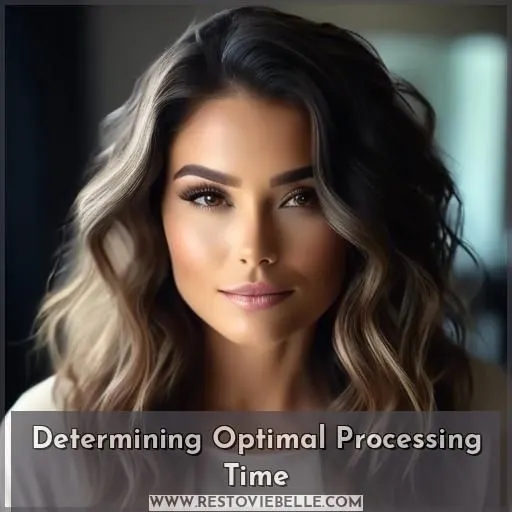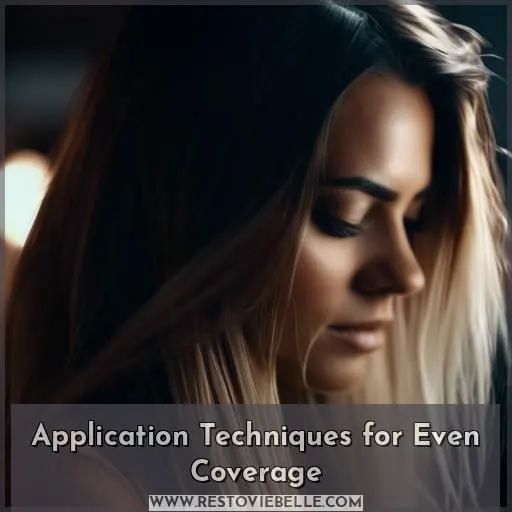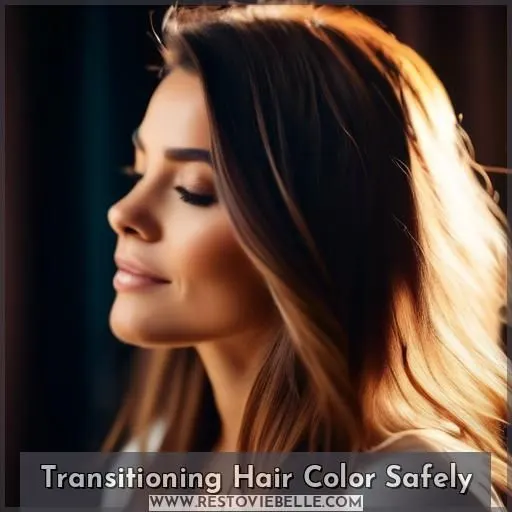This site is supported by our readers. We may earn a commission, at no cost to you, if you purchase through links.

You’ll typically apply 10 volume developer to hair for 15-30 minutes when coloring.
However, the ideal processing time varies based on your hair’s texture, porosity, and color aspirations.
Fine or porous hair may process more rapidly, requiring less time.
While coarse or resistant strands may necessitate more.
Pay close heed during development, monitoring for desired depth and uniformity.
If you’re concealing grays or lightening substantially, the timing may be extended.
Uncertain about the appropriate duration for leaving 10 volume developer on your hair?
Explore the detailed guide below for expert counsel tailored to your individual requirements.
Table Of Contents
- Key Takeaways
- How Long to Leave 10 Volume Developer on Hair?
- Understanding 10 Volume Developer
- Determining Optimal Processing Time
- Mixing Ratios for Desired Results
- Application Techniques for Even Coverage
- Monitoring Development Progress
- Safeguarding Hair Health
- Special Considerations for Grey Coverage
- Troubleshooting Common Developer Issues
- Developer Use in Hair Toning
- Transitioning Hair Color Safely
- Frequently Asked Questions (FAQs)
- Conclusion
Key Takeaways
- 10 volume developer is typically applied to hair for 15-30 minutes, but the ideal processing time varies based on hair texture, porosity, and color aspirations.
- Fine or porous hair may process more rapidly, requiring less time, while coarse or resistant strands may necessitate more.
- Hair texture and porosity can impact the developer’s effectiveness, affecting cuticle damage and pigment oxidation.
- Adjustments for hair length and density, as well as hair color to developer proportions, are essential for even color distribution and minimal damage.
How Long to Leave 10 Volume Developer on Hair?
When using 10 volume developer on hair, it is typically recommended to leave it on for about 30 minutes, but this can vary based on the hair’s condition and desired results. It’s important to follow the specific instructions provided with your hair color product for the best outcome.
Understanding 10 Volume Developer
Understanding 10 Volume Developer
10 Volume Developer is a standard oxidizing level for permanent, no-lift hair color. It’s designed for use when you want to add a color tone or tint to the hair of the same lightness level. It opens the hair cuticle layer, allowing the color molecules to penetrate and deposit in the cortex.
Role in Hair Coloring
10 Volume Developer is an essential component in hair coloring, offering a variety of advantages for achieving the desired color results. Here are some key points to keep in mind:
- Developer consistency: Guarantees smooth mixing and reliable performance for all hair applications.
- Developer cost: Reasonable and widely available, making it a popular option for home hair coloring.
- Developer storage: Stored correctly, developer can maintain its potency for extended periods.
- Developer compatibility: Can be used with various hair colors and types, providing adaptability for different styles.
Effects on Hair Structure
10 Volume Developer plays a vital role in hair coloring.
It aids the penetration of color molecules into the hair shaft.
It interacts with the hair cuticle, which can be low, average, or high in porosity.
The cuticle’s porosity affects the developer’s effectiveness.
Developer penetration is necessary for even color distribution.
However, it can result in cuticle damage if not used appropriately.
Pigment oxidation and protein alteration are fundamental factors in the hair coloring process.
These factors can impact strand elasticity and overall hair health.
Understanding these effects is imperative to obtaining the desired outcome while minimizing damage.
Determining Optimal Processing Time
When determining the ideal processing time for a 10 volume developer, you must consider your hair’s texture and porosity. Delicate or porous hair will process color faster, requiring less time, while thick or resistant hair may need additional processing to achieve the desired result.
Hair Texture Considerations
Regarding hair texture, it’s crucial to note its effect on the coloring process. Here are three key points to think about:
- Uptake and Processing Time: Fine hair tends to take in color more quickly due to its thinner strands, while coarse hair may need additional processing time to achieve desired results. Understanding your hair texture allows your stylist to make necessary adjustments in the color formula and processing time, guaranteeing best color penetration and longevity.
- Color Intensity and Vibrancy: Coarser hair typically reflects more light, resulting in a slightly subdued appearance. Fine hair can often keep color more vibrantly, creating a more intense look. Understanding the natural properties of your hair texture allows your stylist to customize the color formula, guaranteeing that the final result fits your hair’s unique characteristics.
- Damage and Porosity: Hair texture can impact the porosity and overall health of your hair. Coarse or damaged hair may have higher porosity, meaning it can absorb color more quickly but may also be prone to color fading. Fine or healthy hair, on the other hand, may have lower porosity, requiring special attention during the coloring process to make sure adequate color absorption.
Hair Porosity and Developer Interaction
After considering your hair’s texture, let’s delve into how porosity influences your coloring journey. Hair porosity impacts how the developer interacts with your locks, affecting the processing time and potential for damage. Here’s a quick table to guide you:
| Hair Porosity | Developer Volume | Processing Time |
|---|---|---|
| Low | Low volume | Longer |
| Average | Standard strength | Moderate |
| High | Low volume | Shorter |
Mixing Ratios for Desired Results
When mixing for the desired results with 10 volume developer, you should take into account the hair color to developer proportions. The ratio you use should be adapted based on factors like hair length and density to maintain even, consistent color.
Hair Color to Developer Proportions
To obtain optimal outcomes when combining hair color and developer, it’s paramount to comprehend the appropriate ratios and modifications based on your hair’s unique attributes. The suggested ratio for mixing hair dye and developer is typically a 1:2 ratio, where 1 part of hair dye is combined with 2 parts of developer. This ratio guarantees an equal dispersion of color and aids in preventing clumps or uneven application.
When utilizing a 10 volume developer, it’s imperative to take into account the hair’s length, thickness, and desired outcome. For fine hair, a 1:1 ratio may be adequate, while for coarser hair, a 1:2 ratio may be more suitable. Remember, a higher volume developer can damage hair, so it’s vital to utilize the appropriate amount for your hair type.
Adjustments for hair length and density will be addressed in the next subtopic. Stay tuned for further information on how to achieve the best results when mixing hair color and developer.
Adjustments for Hair Length and Density
To achieve the desired result when using 10 Volume Developer, adjustments for hair length and density are essential. Here’s a breakdown of how to make those adjustments:
- Hair Length: If you have longer hair, you may need to use a larger amount of developer to guarantee even coverage. For example, if you have shoulder-length hair, you might consider using a 1:1.5 ratio of hair color to developer. This will help guarantee that the color reaches the entire length of your hair.
- Hair Density: If you have thick hair, you may need to use a smaller amount of developer to avoid over-processing. In this case, you might consider using a 1:1.2 ratio of hair color to developer. This will help guarantee that the developer reaches the hair shaft without causing damage.
- Natural Hair Color: If your hair is naturally darker, you may need to use a larger amount of developer to achieve the desired lift. Conversely, if your hair is naturally lighter, you may need to use a smaller amount of developer to avoid over-processing.
- Desired Outcome: If you’re aiming for a subtle change in color, you can use a smaller amount of developer. However, if you’re looking for a more dramatic change, you may need to use a larger amount of developer.
- Hair Type: Different hair types require different levels of developer. For example, fine hair may require a smaller amount of developer, while coarse hair may require a larger amount.
Application Techniques for Even Coverage
For even coverage, it’s imperative to section your hair appropriately before applying the 10 volume developer. Divide your hair into manageable sections, and apply the developer using gentle strokes, paying extra attention to areas like the hairline, nape, and crown for coarse or resistant hair textures.
Sectioning Hair for Developer Application
To guarantee uniform application when using 10 volume developer, follow these steps:
- Divide your hair into manageable sections.
- Utilize a fine-toothed comb to establish partings.
- Apply developer to each section with a tint brush or applicator.
- Commence at the roots and proceed towards the ends.
- Double-check your application to ensure complete coverage.
- Process at ambient temperature for 35-45 minutes.
- Rinse with warm water and shampoo.
- Adhere to manufacturer’s guidelines for processing time.
Tips for Applying on Different Hair Types
When using Color Fusion Developer, it’s crucial to take into account the hair type and texture to ensure even color saturation and minimize damage. Here are some guidelines for using the developer on various hair types:
- Fine Hair: Fine hair tends to absorb color more quickly, so a lower volume developer (e.g., 10 or 20 vol) is advisable. Additionally, fine hair may require more frequent touch-ups due to its rapid color absorption.
- Medium Hair: Medium hair typically has a moderate color absorption rate. It can tolerate a range of developer volumes, depending on the desired color change.
- Coarse Hair: Coarse hair requires more time for color penetration and may necessitate a higher volume developer (e.g., 30 or 40 vol). However, using a higher volume developer increases the risk of damage, so it’s essential to use a tint brush or a lower volume developer for coarse hair.
- Dense Hair: Dense hair can impede the penetration of liquid, so a tint brush or a lower volume developer is recommended. Furthermore, dense hair may require more time for the developer to work, as the color molecules need to reach the hair shaft.
- Low Porosity Hair: Low porosity hair has a tight cuticle, which can resist moisture and chemicals. A higher volume developer (e.g., 30 or 40 vol) may be necessary to achieve the desired color lift. However, caution is necessary to avoid over-processing the hair, as it can lead to damage.
- High Porosity Hair: High porosity hair has a lifted cuticle, which allows color to penetrate quickly but also fade rapidly. A lower volume developer (e.g., 10 or 20 vol) is recommended to prevent over-processing and damage.
Monitoring Development Progress
Keeping an eye on your hair’s transformation is like watching a pot of water boil – it requires patience but also a sharp eye to avoid a mishap.
Monitoring progress is essential when using a 10 volume developer, as timing is paramount.
Depending on your hair’s porosity and density, the developer will work its magic at varying rates.
This gentle lifting agent subtly coaxes color molecules into action, especially when combined with bleach powder.
Always adhere to the manufacturer’s instructions meticulously, but remember, each head of hair is a distinct canvas.
The key is to find that ideal point where time, developer type, and your hair’s characteristics align, ensuring your locks achieve the desired lift without resorting to a game of chemical roulette.
Safeguarding Hair Health
You want to minimize potential damage when using the lower-lifting 10 volume developer. Proper aftercare is essential to maintaining hair health and vibrancy after the coloring process with this gentle developer strength.
Minimizing Damage With Lower Volumes
When using 10 volume developer, it’s vital to mitigate damage and protect your hair’s well-being. Adjusting developer potency, taking into account hair thickness, and adhering to manufacturer guidelines are paramount. Lower volumes lessen damage, and post-hair color alteration care is indispensable.
Aftercare for Treated Hair
Post-treatment hair care is essential to maintain its well-being. Here are five tips to help your hair stay hydrated, resilient, and radiant:
- Hydrating treatments: Use conditioners and hair masks frequently to trap moisture and reduce damage.
- Deep conditioning: Weekly deep conditioning sessions can aid in restoring hair’s inherent luster and flexibility.
- Protective styling: Choose protective styles such as braids or twists to shield your hair from adverse environmental elements.
- Scalp care: Maintain a clean and healthy scalp by using mild shampoos and steering clear of harsh chemicals.
- Protein treatments: Include protein treatments periodically to fortify your hair and prevent breakage.
Special Considerations for Grey Coverage
When covering stubborn gray hair, you may need to adjust the timing for the 10 volume developer. Gray strands tend to be more resistant and may require leaving the developer on for a longer period to achieve full coverage and seamless blending. However, take care not to over-process, as this can lead to potential damage, dryness, and breakage.
Developer Strength for Resistant Hair
For effective coloring of resistant hair, comprehending developer strength is critical.
For gray coverage, a 1:1 ratio of bleach to developer is advisable to prevent brassiness and shift color to a lighter tone.
However, for hair color change to a darker hue, a 2:1 ratio is more appropriate.
Porosity assessment is essential to determine the optimal developer strength, as thick hair may necessitate a lower concentration.
Always measure developer precisely to avert damage or uneven coloration.
Timing Adjustments for Grey Blending
When blending grey hair, timing adjustments are essential.
For 10 volume developer, adhere to the manufacturer’s guidelines for processing time. However, if your hair structure is delicate or has minimal porosity, you may need to modify the time.
Fine hair absorbs color swiftly, necessitating a shorter processing period. Low porosity hair has a compact cuticle that resists color absorption, necessitating a longer processing time.
Invariably mix your hair dye with developer in a 1:2 ratio and apply evenly to your hair.
For bleaching eyebrows, utilize a violet or blue bleach powder for toning and start with a lower volume developer for sensitive skin or dark brows.
Troubleshooting Common Developer Issues
Over-processing with a 10 volume developer can lead to hair dryness, breakage, and uneven, undesirable tones.
You’ll want to closely monitor the development process and immediately rinse out the color if you notice signs of over-processing, such as an overly lightened base or markedly porous hair texture.
Underprocessing, on the other hand, may result in patchy, uneven color or failure to achieve the desired level of lift or tone.
In such cases, you may need to re-apply color with a higher volume developer or leave it on longer, taking care not to over-process.
Over-Processing and Its Signs
Over-processing isn’t just a hair color disaster; it’s a cry for help from your locks. When you leave that 20 volume developer on for too long, your hair’s texture and porosity take a hit. Here’s what to watch for:
- Brittle strands that snap easily
- Color that’s more yikes than yes
- A texture that’s seen better days
- Dryness that could rival the Sahara
Under-Processing and Color Correction
Under-processing your hair can lead to uneven coverage, brassiness, and fading.
To correct this, follow the manufacturer’s instructions for processing time.
If the color still appears uneven, consider using a lower volume developer or a violet-tinted developer for toning.
For eyebrow bleaching, wait 10 minutes for 10 vol. and 12 minutes for 20 vol. before removal.
Remember to apply oil or moisturizer after bleaching, and wait several hours before applying makeup.
Developer Use in Hair Toning
For toning hair, you’ll need to balance the right amount of 10 volume developer with your toning product. The developer activates and deposits the toner, allowing you to achieve your desired cool, ashy, or dimensional tones with precise control over the processing time.
Balancing Toner With 10 Volume Developer
Balancing toner with 10 volume developer is a vital step in achieving the ideal hair color. Here are three ways to guarantee a successful toning process:
- Volume Proportion: Combine bleach toner with 10 volume developer in a 1:1 ratio for the best results.
- Application Method: Apply the mixture evenly on your hair, focusing on the areas that require toning.
- Color Correction: If the color appears too light, allow the toner to remain on for a few more minutes. If it’s too dark, rinse it off and reapply the toner with a lower volume developer. Always adhere to the manufacturer’s instructions for processing time.
Achieving Desired Tones
To achieve your desired tones using 10 volume developer, follow these steps:
- Choose the right toner: Select a toner with a blue or purple base to neutralize yellow and produce the desired ash blonde tone. For example, use a purple or blue-based toner with 10 volume developer in a 1:2 ratio.
- Apply evenly: Apply the toner to your hair evenly, ensuring that it covers all strands. Be sure to apply it to the roots as well as the ends.
- Process the toner: Wait for the toner to process, usually for 10-12 minutes, depending on the desired level of toning.
- Rinse and shampoo: After the toner has processed, rinse your hair thoroughly with warm water and then shampoo it using a purple shampoo to help maintain the ash blonde tone.
- Maintain the tone: Use a purple shampoo or mask once a week to help keep your hair ash blonde and prevent yellow from returning.
Transitioning Hair Color Safely
When shifting to a new hair color, utilizing a 10 volume developer enables incremental and measured lightening, reducing prospective harm. By treating for the suitable duration based on your hair’s state and intended result, you can securely execute a seamless color alteration while preserving the well-being of your tresses.
Gradual Lifting With 10 Volume Developer
Regarding gradual lifting with 10 volume developer, it’s crucial to consider the following:
- Bleach Baths: Gradual lightening can be achieved through consistent bleach baths, involving applying a reduced amount of bleach to your hair over time to achieve a brighter shade.
- Low Porosity Hair: If your hair has low porosity, you may need to modify the processing time to guarantee even lightening.
- Color Correction: If you’re not obtaining the desired results, think about adjusting your developer volume or using a color correction product.
- Manufacturer’s Instructions: Always adhere to the manufacturer’s instructions for processing time and volume adjustments.
- Modern Virgin Application: For those seeking to extend eyebrows, gradual lifting with 10 volume developer can assist in maintaining a clean appearance while facilitating shaping.
- Eyebrow Maintenance: Regular touch-ups every 10-23 days can help keep your eyebrows looking optimal.
Maintaining Hair Integrity During Color Changes
To preserve hair integrity during color alterations, it’s crucial to account for the effect of developer choice, hair receptiveness, and color coordination. Here’s a 3×5 table to assist you:
| Factor | Consideration | Impact |
|---|---|---|
| Developer Choice | Opt for a developer with a lower strength, such as 10 or 20, for gradual lightening and reduced damage. | Milder developers are more gentle on hair and lower the risk of excessive processing. |
| Hair Receptiveness | Determine your hair’s receptiveness level to adjust processing time and developer choice. | Highly receptive hair may require shorter processing times, while less receptive hair may need longer times. |
| Color Coordination | Progressively shift towards your desired color to prevent abrupt changes that can harm hair. | Gradual color shifts allow hair to adapt, minimizing the risk of breakage. |
Frequently Asked Questions (FAQs)
What is the recommended processing time for 10 volume developer on hair?
You’ll typically want to leave a 10 volume developer on for 20-30 minutes. This low-lift formula gently opens the cuticle for toning or depositing color without drastically lightening. But always check the specific product instructions for best results.
Can 10 volume developer be used with bleach?
Why limit your creative flair? You can certainly experiment with 10 volume developer and bleach. Just keep an eye on it – lower volumes process slower but offer more control. Have fun transforming those tresses!
Is 10 volume developer suitable for fine hair?
You bet, 10 volume developer is a great choice for fine hair! Its gentle lifting power won’t overwhelm those delicate strands. So go ahead, give your fine tresses a vibrant new hue with confidence.
How does 10 volume developer compare to other developer strengths?
You’re a clever chap! 10 volume is the mildest developer, perfect for adjusting or renewing color. 20 volume raises up to 2 levels, 30 volume up to 3, and 40 volume is the heavy-hitter – lifting 4+ levels! Choose your strength based on the desired lightness you’re aiming for.
Can 10 volume developer be used for grey coverage?
You bet! While 10 vol. developer won’t lift hair color much, it’s perfect for blending grays when used with permanent dye. It gently opens the cuticle to let that rich color sink in and camouflage those pesky whites.
Conclusion
As you move to a new shade, allowing 10 volume developer to stay on hair for the ideal time guarantees vivid, seamless results.
Whether adjusting tone, lightening, or concealing grays, you’ve now acquired knowledge about timing adjustments for various hair types and absorption capacities.
With attention and observation, employing the appropriate developer strength shields hair health during color transformations.
By adhering to this thorough guide on how long to apply 10 volume developer to hair, you can confidently attain your desired color while preserving your hair’s beauty.















